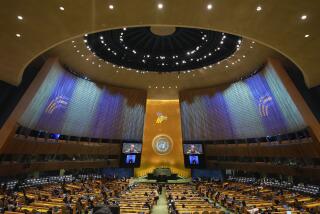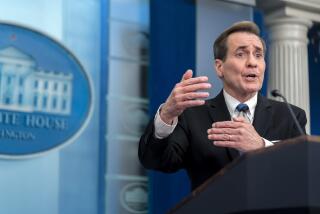Soviet SDI Stance Still a Barrier, Reagan Says : He Indicates Moscow Opposition Could Prevent New Accord to Halve Nations’ Strategic Weapons
WASHINGTON — President Reagan, taking a somewhat more cautious line than he did immediately after the summit, indicated Saturday that Soviet opposition to his Strategic Defense Initiative to develop a missile defense system could still prevent a new agreement to cut strategic offensive weapons by half. In his weekly radio address, which he delivered from Camp David, Md., the President said progress had been made toward getting agreement for such a reduction by the time he visits Moscow next spring.
“This could be another historic achievement,” he said, alluding to the medium-range missile treaty signed here last week, “provided the Soviets don’t try to hold it hostage to restrictions on SDI. . . . Our bottom line on SDI is simple: We will research it, we will test it, and when it’s ready, we will deploy it,” he added, repeating past formulations.
His words and tone contrasted to his comments Friday, in the almost euphoric wake of the U.S.-Soviet summit, when he told a news conference for out-of-town reporters that past Soviet demands for restrictions on SDI were “eliminated.”
Asked then if the joint U.S.-Soviet summit statement resolved or postponed the SDI issue, Reagan responded that “it resolves it.” He added, “I don’t think there is an impediment there at all.”
‘Congratulations Are in Order’
But while not all the obstacles to new U.S.-Soviet agreements were out of the way, there was no backtracking by Administration officials from their claim of major forward progress in the field of arms control. “There is no cause for euphoria, but I do think congratulations are in order,” said a senior official who was intimately involved in the summit.
The Democrats sent a congratulatory message, of sorts, to the President. Rep. Stephen J. Solarz (D-N.Y.), delivering his party’s response to Reagan’s radio address, said the medium-range missile treaty was “a small step forward for mankind and a great step forward for President Reagan.”
“We only wish the Republcan Party would provide the President with the same strong support (in ratification proceedings) that he will be able to count on from the Democratic Party,” Solarz said.
Summit appraisals by some who served earlier in the Reagan Administration produced tepid praise and even criticism.
Jeane J. Kirkpatrick, former ambassador to the United Nations, said that she had been afraid Reagan might “give away the store.” But there were “no unprepared decisions and no undesirable concessions,” she said, “no breakthroughs, no surprises, no gifts.”
Weak on Human Rights
Richard N. Perle, who was assistant defense secretary until several months ago, complained that the summit had been dominated by arms issues. “The final statement is very weak on the subject of human rights,” with only a single sentence on the issue, he noted, and “weak in the general area of regional conflicts” such as Afghanistan.
Reagan’s insistence Saturday that he would not abandon SDI, which is popularly called “Star Wars,” dealt with a somewhat artificial aspect to the anti-missile defense question. Soviet leader Mikhail S. Gorbachev has himself said several times that the Soviets do not seek to curb SDI.
But the Soviets still want to constrain the U.S. space defense effort through the Anti-Missile Ballistic Treaty, which bars deployment of such defenses, so it was the wording in the “joint summit statement” on the ABM treaty that drew great attention and becomes the basis for judging how much progress was in fact made.
In that statement, the Soviets did not formally relinquish their goal of curbing U.S. missile defense efforts as a price for a strategic arms reduction treaty. As such, they can always resurrect their demands to abort negotiations on the offensive arms treaty.
But the Soviets did accept more flexible language on what kind of missile defense work is permitted under the ABM treaty by dropping their previous insistence that such work be strictly limited. And they accepted the U.S. view that after some period during which missile defenses could not be erected, each side would be free to build such a shield.
White House View on Issue
Lt. Gen. Colin L. Powell, the President’s national security adviser, declined to say that the Soviets yielded on these points. But he clearly indicated that the Administration won much of its case when, during a CNN television interview Friday, he explained the White House’s view of the two key sentences in the joint statement.
The first sentence said that “taking into account” efforts to reach the arms reduction treaty, the two leaders instructed their negotiators to “work out an agreement that would commit the two sides to observe the ABM treaty, as signed in 1972, while conducting their research, development and testing as required, which are permitted by the ABM treaty, and not to withdraw from the ABM treaty for a specified period of time.”
Powell explained that the phrase as required “to us means: as required to further our SDI program in the manner in which the President has laid it out. And (Defense) Secretary (Frank C.) Carlucci, in the next year and a half or so, will be presenting to the Congress those tests that are required to further the program along.”
(Secretary of State George P. Shultz, in Europe to explain summit results to the North Atlantic Treaty Organization allies, said the Administration would no longer try to persuade Congress that the ABM treaty should be broadly, or permissively, interpreted, thereby finessing the battle with congressional Democrats who insist that the treaty must be narrowly interpreted to permit only limited testing. Each SDI experiment will be decided on a case-by-case basis, he said, according to a Times report by Norman Kempster.)
The second key sentence in the joint summit statement dealt with the period of time to be negotiated (the United States has proposed about seven years, to Dec. 31, 1994, while the Soviets offered 10 years) during which neither side will withdraw from the ABM accord and what happens after that. The Soviets wanted the ABM treaty to remain in force, to prevent deployment of missile defenses, while the United States wanted to deploy defenses afterward.
‘Intensive Discussions’
The statement said that “intensive discussions” will begin three years before the end of the no-withdrawal period on what is to happen after that period. But it added that at the end of the period, “in the event that the sides have not agreed otherwise, each side will be free to decide its course of action.”
Powell explained that this means “at the end of this period of continued compliance, the United States reserves its right at that time to deploy SDI if we have demonstrated that it is a workable, satisfactory solution to the problem of strategic stability.”
Powell also indicated that Reagan already has some ideas about his Moscow visit. He tentatively intends “to spend more time in Moscow than (Gorbachev) was able to spend here in the United States,” Powell said.
The Moscow summit will be “a business meeting,” Powell added, “but I think the President might also try to find some time to get to know the Soviet Union . . . and the Soviet people a little better . . . and let the Soviet people get to know President Reagan a lot better.”
More to Read
Sign up for Essential California
The most important California stories and recommendations in your inbox every morning.
You may occasionally receive promotional content from the Los Angeles Times.










